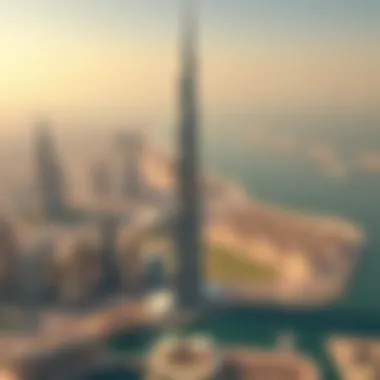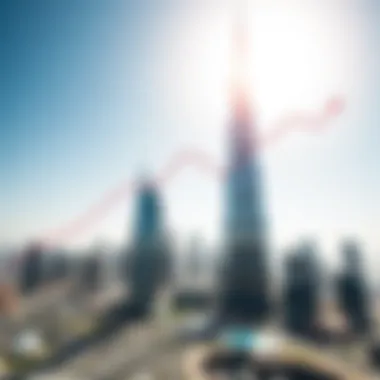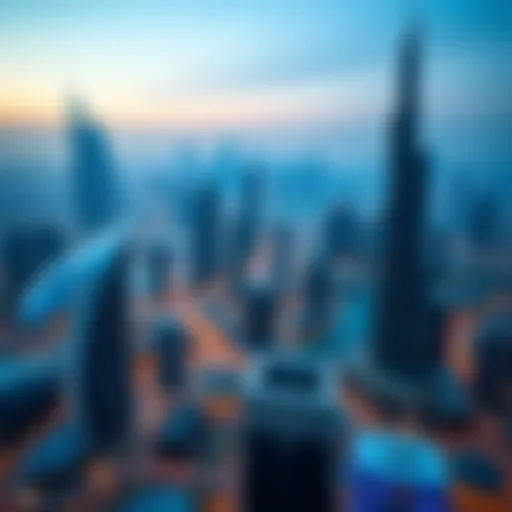Analyzing the Financial Impact of the Burj Khalifa


Intro
The Burj Khalifa, an architectural marvel, stands as a testament to human ingenuity and ambition. It not only dominates the skyline of Dubai but also mirrors the economic aspirations of a rapidly growing city. With its extraordinary height of 828 meters, this skyscraper is more than just a building; it is a symbol of a new era in urban development. The financial implications tied to its construction, operation, and subsequent impact on the property market are vast and multifaceted.
In this analysis, we will delve deep into the costs associated with the Burj Khalifa. Understanding these expenses gives key insights into the economic landscape of Dubai, particularly for those considering investment opportunities or developments in the region. We will dissect the breakdown of construction costs, the innovative strategies that propelled the project forward, and the ripple effects it has had on real estate in Dubai.
As we explore these intricate details, we will touch on the broader implications for investors, buyers, and developers, providing a comprehensive guide to the financial landscape shaped by this incredible structure. A closer examination of current market trends and buying-selling dynamics will be presented, giving those involved in property transactions a stable footing in understanding their ventures in Dubai's real estate market.
Prelude to Burj Khalifa
The Burj Khalifa, standing tall at a height of 828 meters, is not merely a marvel of engineering; it embodies the aspirations of a nation. It's critical to delve into this iconic structure not just to appreciate its aesthetics, but to understand the multifaceted financial implications related to its construction and ongoing impact on Dubai's economy. The Burj Khalifa pushes the boundaries of traditional skyscraper design, leading to significant costs associated with innovative materials, advanced technologies, and skilled labor. This article will dissect these elements to provide insights into the financial landscape shaped by this landmark building.
Overview of the Burj Khalifa
The Burj Khalifa, designed by the renowned architecture firm Skidmore, Owings & Merrill, became the tallest structure in the world when it opened in 2010. This architectural titan is as much a symbol of Dubai's rapid growth and ambition as it is a functioning space that includes residential units, office spaces, and even a hotel. The cost of constructing the Burj Khalifa is staggering, with estimates reaching around $1.5 billion, which raises questions about budget allocation and financial management during its build.
Key elements worth noting about the Burj Khalifa include its unique design, which resembles the Hymenocallis flower, and its core structure that is specifically engineered to withstand Dubai's extreme weather conditions. This skyscraper is not just a place for people to live or work; it is a beacon of technology and a testament to what is possible when art meets science.
Significance in Architectural History
The Burj Khalifa represents a watershed moment in both architectural design and urban development. It's not just about being the tallest; it's about what the building signifies for future projects and the industry as a whole.
- A New Era of Skyscrapers: The design and engineering breakthroughs that came with the Burj Khalifa paved the way for future constructions that aspire to push the limits of what we think a building can do.
- Cultural Impact: It serves as a catalyst for tourism in Dubai, with millions flocking to experience its observation decks and the mesmerizing fountain show below.
- Economic Indicator: Its presence has significantly influenced local real estate prices and investment opportunities in the vicinity, drawing in international stakeholders.
"The Burj Khalifa is not a mere structure; it's an embodiment of human ingenuity and ambition."
Thus, understanding the Burj Khalifa is crucial for investors, agents, and developers as it highlights essential lessons in financing, construction budgeting, and long-term impacts in a rapidly evolving real estate market.
Construction Cost Breakdown
Understanding the construction cost breakdown of the Burj Khalifa is crucial for grasping the overall financial implications of this monumental project. The cost analysis sheds light on how certain factors influenced both the budget and the final expenditures. Knowing these details can enrich comprehension for potential investors, developers, and stakeholders who are keen on learning from past experiences in Dubai's unique real estate landscape.
Initial Budget Projections
When the Burj Khalifa project first began, initial budget projections estimated the costs at around $400 million. This number seems rather modest when juxtaposed with the final tally, which soared over $1.5 billion by the project's completion. Originally, these estimations were rooted in earlier developments in the region, yet they did not fully account for the ambitious nature of this skyscraper. As the design evolved, so too did the budget; concerns regarding inflation of materials within the supply chain, labor disputes, and the unique architectural challenges also played pivotal roles.
Actual Costs vs. Budgeted Costs
A detailed examination reveals a stark contrast between the budgeted costs and the actual expenses incurred. While the original projections laid out the groundwork, the actual costs were not just a minor overrun; they represented a sizable increase. The final costs, surpassed dramatically, resulting from factors like enhanced safety measures, artistic design features, and advanced technologies that pushed the envelope of construction. Even seasoned investors would have been blindsided by the financial leap witnessed throughout the project.
Major Cost Contributors
The core of the Burj Khalifa's cost breakdown can be distilled into three major contributors: materials and resources, labor costs, and technological innovations.
Materials and Resources
The materials used in constructing the Burj Khalifa are not your run-of-the-mill lumber and bricks. It required cutting-edge resources like high-strength concrete, which ensures stability and durability. The key characteristic of this material lies in its capacity to withstand the extreme temperatures prevalent in an environment like Dubai.
Utilizing materials like this proved not only beneficial for structural integrity but also a worthwhile investment in the long-term sustainability of the building. However, sourcing these materials led to notable delays and budgeting woes, creating strains that pressured the overall costs. At the end of the day, the choice of materials is always a balance between cost and quality, which means that sometimes, cutting corners can have consequences.
Labor Costs


Labor costs presented another substantial segment of the expenditure. The Burj Khalifa's construction involved thousands of skilled workers from various countries, each contributing their expertise to this iconic structure. The key feature of these labor costs was the necessity for specialized skills that were not readily available in the local market, which ramped up labor expenses considerably.
This unique labor dynamic underscored the complexities involved in international construction projects. However, while higher labor costs were unavoidable, they arguably contributed to the building’s world-class craftsmanship and safety standards.
Technological Innovations
In terms of technological innovations, the Burj Khalifa embraced cutting-edge technologies in its design and construction phases. The use of innovative engineering solutions significantly improved safety measures and environmental sustainability efforts. This unique aspect reflects how the building is not just a feat of architecture but also a model of modern engineering excellence.
Yet, it should be noted that incorporating these advanced technologies required considerable financial investment upfront. The returns of such investments, however, tend to reveal themselves over time, especially in energy efficiency and maintenance costs. This paradox reflects broader tensions: balancing immediate expenses against long-term benefits is a dance that many large projects face.
The Burj Khalifa is not just a structure; it's a mix of careful planning, costly materials, skilled labor, and pioneering technology, all wrapped into one ambitious package.
Understanding these major cost contributors provides insight into how similar projects might be managed in the future. The financial lessons learned here could be immensely beneficial for those looking to invest or engage in large-scale developments.
Funding Sources
The financial landscape of the Burj Khalifa is quite intricate, shaped by a blend of public and private financing along with international collaborations. Understanding the funding sources is pivotal to grasping the broader implications of such a monumental project. Investing in the construction of the Burj Khalifa wasn’t just about erecting a tall structure; it reflected a significant commitment from various stakeholders who believed in Dubai's potential as a global city. This section will explore the diverse funding mechanisms that brought the Burj Khalifa to life.
Public Financing
Public financing played a crucial role in the development of the Burj Khalifa. The Dubai government, recognizing the building's potential to elevate the city's status, committed substantial public funds. Initiatives like the Dubai Urban Master Plan directly tied public investment to the Burj Khalifa project, intending to create a landmark that represents the kingdom's ambition. Local authorities also offered incentives, tax breaks, and subsidies to project sponsors, which greatly boosted investor confidence.
Moreover, the return on this investment was envisioned not just in immediate financial terms but as part of a larger strategy to attract tourists and businesses. The idea was to weave the Burj Khalifa into the very fabric of Dubai's identity, making it a must-see destination. The combination of government funding and strategic urban planning meant that the Burj Khalifa wasn't just a structure; it was part of a broader economic vision.
Private Investments
Private investments indeed were the lifeblood of the financing structure for the Burj Khalifa. Emaar Properties, the developer, secured funding through a mix of local and international investors. This blend not only helped to mitigate risks but also brought in expertise from different markets. Private equity firms, real estate funds, and high net-worth individuals invested, attracted by the promise of hefty returns in a booming market.
Key players included firms like the Abu Dhabi Investment Authority which provided significant capital. The attractiveness of Dubai as a haven for business, with its tax-free benefits, further sweetened the deal. The investment also allowed for innovative designs and materials that eventually made the Burj Khalifa stand tall as an engineering marvel. Without private investments, the crafting of such an iconic structure wouldn’t have been feasible.
International Partnerships
International partnerships added a layer of complexity and strength to the funding sources of the Burj Khalifa. Various architectural and engineering firms from across the globe were brought on board, with each contributing their specific expertise. For instance, the architectural design was led by Skidmore, Owings & Merrill, a firm based in the United States, while Buro Happold from the UK focused on engineering solutions.
Such partnerships not only tapped into global expertise but also dispersed financial risks associated with such a grand project. Beyond construction, international partnerships included marketing strategies that targeted expatriates and wealthy individuals across continents. These collaborations enhanced the Burj Khalifa’s profile, making it recognizable worldwide and thus more enticing to investors and tourists alike.
"The Burj Khalifa is not merely a building; it’s a testament to what collaboration can achieve at an international level."
Ultimately, the funding sources of the Burj Khalifa reflect a careful balance of public good, private gain, and worldwide collaboration – creating a model that future projects could aspire to emulate.
Economic Impact on Dubai
The Burj Khalifa does not merely scrape the sky; it profoundly influences the economic landscape of Dubai. This towering structure symbolizes ambition and innovation while serving as a catalyst for numerous economic activities. Here, we delve into the substantial facets of its economic impact, focusing on tourism revenues, real estate dynamics, and job generation. These elements are vital for anyone interested in understanding the broader implications of such a grand undertaking.
Tourism Revenue Generation
Tourism is often viewed as the lifeblood of Dubai's economy, and the Burj Khalifa plays a starring role in this narrative. With its breathtaking design and status as the tallest building in the world, the Burj Khalifa has become a major draw for visitors from across the globe. In fact, estimates suggest that the tower attracts over 1.5 million visitors every year, contributing significantly to local businesses.
- The At the Top observation deck offers stunning panoramic views, which generate tickets sales and ancillary services.
- Surrounding areas, such as the Dubai Mall and the Dubai Fountain, further enhance the visitor experience, encouraging them to spend on dining, shopping, and entertainment.
- Local businesses, from hotels to restaurants, have witnessed increased patronage, creating a ripple effect throughout the hospitality sector.
This influx of tourists not only supports such establishments but also boosts government revenues through taxes and tourism-related fees. Consequently, the Burj Khalifa stands as a pillar of the tourism economy, reaffirming the idea that a single architectural feat can yield ongoing economic benefits.
Impact on Local Real Estate Prices
The Burj Khalifa’s influence extends beyond tourism—it has secured a position as a linchpin in Dubai’s real estate market. Properties near this iconic skyscraper have experienced notable price fluctuations because of its prestigious presence.


- Proximity to Landmark: Being situated near the Burj Khalifa is akin to holding a golden ticket in real estate terms. Properties in Downtown Dubai have seen their values soar, driven by the desirability of living close to such a landmark.
- Luxury Developments: With the rise of luxury developments in the surrounding area, investors have jumped at opportunities to capitalize on this trend, leading to an increase in high-end property offerings.
- Market Confidence: The construction of the Burj Khalifa reflects Dubai's growth and resilience, instilling confidence in potential buyers. This phenomenon often translates into inflated property values as demand surges amidst the allure of an emblematic structure.
In essence, the Burj Khalifa does not just change the skyline; it reshapes the real estate landscape by intensifying competition for prime properties, altering market perceptions and behavior.
Job Creation and Economic Growth
The construction and maintenance of the Burj Khalifa have spurred considerable job creation and economic growth in Dubai. During its construction, thousands of jobs were created, providing not only employment for individuals in the city but also boosting the local economy.
- Construction Jobs: Laborers, engineers, architects, and project managers found work on the project, and these jobs injected money into local economies.
- Service Sector Jobs: Upon completion, the Burj Khalifa created ongoing employment opportunities, particularly in hospitality, retail, and tourism, as businesses flourished around the landmark. From hotel staff to security personnel, the tower has become a steady source of jobs.
- Induced Growth: The increased economic activities surrounding the Burj Khalifa have led to the rise of additional businesses, further stimulating job creation. As visitors flock to the area, demand escalates for services ranging from guided tours to luxury dining experiences.
Overall, the Burj Khalifa has triggered a domino effect, where job creation complements economic growth, underscoring the importance of strategic investment in iconic projects.
The Burj Khalifa acts as more than just a building; it is a powerful driver of economic growth for Dubai, shaping various sectors and creating opportunities.
By examining these facets, the Burj Khalifa exemplifies the interplay between architectural grandeur and economic vitality, demonstrating how such marvels can enhance a city’s financial landscape.
Comparative Analysis with Other Skyscrapers
A comparative analysis with other skyscrapers is crucial to appreciate the Burj Khalifa not just as a standalone marvel, but in the context of global architectural achievements. By examining the cost structures, design philosophies, and construction techniques of similar structures, we gain insights into what makes the Burj Khalifa unique and also what it shares with its towering counterparts. This section delves into key elements that surround the comparison, enabling investors and stakeholders to grasp the implications of having such an iconic presence in Dubai's skyline.
Cost Comparison with Similar Structures
When looking at the Burj Khalifa, it's impossible not to draw comparisons with other monumental skyscrapers like the Shanghai Tower or One World Trade Center. The Burj Khalifa, with its estimated construction cost of around 1.5 billion dollars, stands out, but a closer glance reveals intriguing patterns in cost breakdowns across these high-rises.
- Shanghai Tower: Known for its spiraling design, it completed its construction at roughly 2.4 billion dollars. Notably, this higher cost can be attributed to the use of advanced technologies designed to enhance energy efficiency and resilience against earthquakes.
- One World Trade Center: This structure had a total cost of about 3.9 billion dollars, making it one of the most expensive ever built. Security features and meticulous attention to memorializing its historical context significantly pushed costs upward.
An analysis of these costs highlights that while the Burj Khalifa might not hold the lowest construction expenses, its value emerges in the return on investment it generates through tourism and business attraction.
Design and Construction Techniques
The Burj Khalifa employs a unique design that blends innovative construction techniques with an ambitious vision. Unlike other skyscrapers, which might follow a more traditional vertical pattern, its distinctive Y-shaped layout provides structural integrity and aesthetic appeal.
- Modular construction: This technique, utilized in its building, allowed for quicker assembly, where sections of the tower were pre-fabricated and assembled onsite, which is not always the case in similar constructions.
- Core design: The central core system, which supports the immense weight of the structure, differs from the strategies used in Shanghai Tower and others. This system limits lateral movement, ensuring stability against high winds, which is essential in Dubai's desert climate.
The fusion of technology and architecture not only defines the building but also sets a benchmark for future constructions, offering lessons that other projects can take note of.
Cultural Significance in Context
Beyond costs and construction methods, cultural significance plays a pivotal role in comparing skyscrapers. For many, the Burj Khalifa symbolizes the ambition and resilience of Dubai. This is a stark contrast to structures like the Taipei 101, which reflects Taiwan's aspirations and heritage.
The Burj Khalifa’s prominence is amplified as an emblem of modernity within a rapidly developing Middle Eastern context. It draws tourists from all corners of the globe, contributing to Dubai's reputation as a dynamic hub for commerce and tourism. Its presence transforms not just the skyline but also the socio-economic fabric of its environment.
Long-term Financial Considerations
When diving into the financial implications tied to the Burj Khalifa, a notable focus must be put on long-term financial considerations. These considerations pave the way not just for understanding the costs accrued during the construction phase but also for examining ongoing financial sustainability and the potential returns from this iconic structure. Investing in such a grand endeavor requires a look beyond initial expenditure — it’s essential to weigh the enduring impacts on ROI, maintenance, and operational costs.
Return on Investment Analysis
In the realm of towering skyscrapers, the phrase "Return on Investment" often speaks volumes. The Burj Khalifa, since its completion, has become a significant player in the real estate market of Dubai. Investors who placed their bets on this monumental project have found that the initial costs were mere stepping stones toward a much larger financial picture.
The financial narratives surrounding the Burj Khalifa highlight its contribution to local tourism and real estate value. The numbers tell a compelling story: the increased footfall in the area has led to a sharp rise in commercial property values. For instance, leasing space in the vicinity of the Burj has become golden real estate, often fetching higher rates compared to other areas in Dubai.
Moreover, foreign investments have indeed been influenced by the presence of landmark projects like this. Investing in luxury apartments or office spaces located in the shadows of the Burj announces to the world a stake in the vibrant growth of Dubai. In comparison to other skyscrapers globally, the Burj Khalifa often balances its high maintenance costs against lucrative returns from property rents and tourism-driven economic boosts.


“The Burj Khalifa is not just a building; it's an investment in the future of Dubai.”
Maintenance and Operational Costs
Once the dust has settled and the last brick in the Burj is placed, the narrative of expenditure does not end. The operational costs are hefty but essential to keep the spark alive in this architectural marvel. Maintaining a structure of such grandeur is akin to keeping a well-oiled machine running.
The Burj Khalifa’s maintenance requirements are extensive. For one, the building commands a significant budget for routine inspections, cleaning, and general upkeep – just imagine the task of maintaining not just the structure’s exterior but also its interior facilities and amenities that cater to both residents and tourists. Common operational costs can include:
- Cleaning Services: Keeping the façade free of dust and grime from the desert air.
- Security Services: Ensuring safety for both visitors and occupants, which adds to expenses.
- Utilities: Water and energy consumption skyrocket in a high-rise; powering the elevators alone takes a considerable amount of energy.
- Staff Salaries: From management to maintenance personnel, staffing is a continuous expense.
However, while these costs may appear daunting, they are often offset by the financial gains in tourism, hospitality, and business leasing. The Burj Khalifa serves as a magnet, attracting a continuous flow of visitors, which in turn facilitates steady revenue streams, empowering both operator and investor alike.
The financial model of the Burj Khalifa emphasizes the importance of long-term planning. While the world marvels at its height, those with a keen eye for finance see the calculations that underscore its enduring value in the ever-evolving Dubai landscape.
Future Developments in Dubai Real Estate
The real estate landscape in Dubai is undergoing rapid evolution, particularly as it takes cues from landmark projects like the Burj Khalifa. This structure not only stands as an architectural marvel but also serves as a catalyst for future developments in the region. Analyzing upcoming projects can lend insights into trends and investments that could shape Dubai’s urban environment.
Emerging Projects Inspired by Burj Khalifa
Dubai is not the kind of city to rest on its laurels. The Burj Khalifa has sparked numerous projects that aim to replicate its success or even push the envelope further. Projects like the Dubai Creek Tower and the upcoming Marsa Al Arab focus on blending luxury and innovation. These newer developments not only target high-end clientele but also aim to attract business ventures, ideally turning Dubai into a global hub for commerce.
- Dubai Creek Tower: This tower is expected to surpass the Burj Khalifa in height, featuring a stunning design that reflects the heritage of Dubai.
- Marsa Al Arab: This ambitious project aims to develop resort-style living with a marina view, enticing both tourists and residents.
These projects echo the lessons learned from the Burj Khalifa's development, underscoring the importance of striking a balance between aesthetic appeal and operational sustainability. Investors and developers are now more attuned to integrating advanced technologies into their designs, aiming for not just beauty but environmental efficiency as well.
Influence on City Planning
City planning in Dubai is being profoundly shaped by the Burj Khalifa’s architectural legacy. This tower acts as a focal point in urban design discussions, pushing planners to think beyond traditional limits. Among key considerations are the need for infrastructure that can support increased foot traffic and the incorporation of green spaces amid the bustling skyscraper environment.
- Infrastructure Development: Roads and public transport systems are being designed to facilitate access to new developments, ensuring fluidity among the interconnected projects.
- Urban Green Spaces: As the skyline grows denser, there’s a push to create parks and recreational spaces that offer a respite from urban life, thus enhancing the quality of life in these burgeoning communities.
"The vision for Dubai transcends construction; it's about crafting a livable, sustainable future that harmonizes with its past."
Such shifts in planning are enticing to investors who see that a well-rounded approach can translate into long-term gains. Understanding these dynamics will be crucial for stakeholders looking to navigate the evolving real estate market in Dubai as it continues to take bold steps into the future.
Culmination
When it comes to the financial implications of the Burj Khalifa, the conclusion is not merely a recap of previous points. Instead, it serves as an essential reflection on the insights gained from this iconic structure's journey. The Burj Khalifa stands as a testament not just to architectural brilliance, but also to the complex financial dynamics at play in such monumental projects. Through its construction, we uncover critical lessons that apply broadly across the real estate sector and inspire future endeavors worldwide.
Reflections on the Financial Lessons
The financial trajectory of the Burj Khalifa offers several key takeaways that investors and developers should carefully consider. First off, the importance of thorough budget planning cannot be overstated. Initial projections can easily fall short when faced with unexpected challenges. As seen in the Burj’s case, costs escalated due to various factors, including material prices and labor concerns. In a nutshell, having a contingency plan is vital — a cushion that can absorb shocks during the project lifecycle.
Moreover, the value of transparent funding sources plays a pivotal role. The combination of public financing, private investment, and international partnerships creates a diverse financial portfolio, ultimately supporting resilience against economic fluctuations. Strengthening relationships with investors and stakeholders enhances credibility and supports the long-term viability of the project.
"The Burj Khalifa's financial narrative is a reminder that success often lies in adaptability."
Lastly, the ongoing operational costs of such a magnificent structure remind us that the initial outlay is just the tip of the iceberg. Maintenance and upkeep strike a heavy blow against the budgets of many iconic buildings. Investors should learn to anticipate these future expenses, ensuring that profitability remains in sight.
Implications for Future Real Estate Projects
The lessons drawn from the Burj Khalifa's construction extend far into the realm of future real estate endeavors. Between innovative design practices and the intricate balance of architecture and finances, projects moving forward should incorporate these teachings into their planning stages.
What particularly stands out is the significance of sustainability. As cities become more crowded and resources more limited, incorporating eco-friendly materials and processes could not only reduce long-term costs but also appeal to a growing segment of environmentally-conscious buyers. Making green choices could turn out to be a selling point in upcoming developments.
Furthermore, developers must remain vigilant about city planning influences. Urban landscapes continue to shift and adapt in response to iconic structures like the Burj Khalifa. Therefore, anticipating changes in local real estate markets is essential. Strong infrastructure support around new projects will secure their relevance and attractiveness to buyers.
In summary, the Burj Khalifa is more than a skyscraper; it’s a case study on the financial intricacies of monumental projects. Its conclusion should steer attendees — be they developers, investors, or agents — toward better practices, emphasizing clear financial strategies and foresight in expenditures. As the skyline of cityscapes continues to evolve, the lessons learned from this high-rise marvel will undoubtedly guide the architects of tomorrow.











